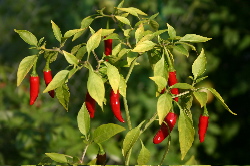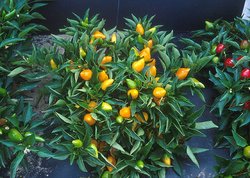Capsicum
|
|
| Capsicum | ||||||||||||||
|---|---|---|---|---|---|---|---|---|---|---|---|---|---|---|
| Missing image Capsicum_annuum_Bluete.jpg Capsicum annuum in bloom | ||||||||||||||
| Scientific classification | ||||||||||||||
| ||||||||||||||
| Species | ||||||||||||||
|
Capsicum is a genus of plants from the nightshade family (Solanaceae). Some of the members of Capsicum are used as spices, vegetables, and medicines. The fruit of Capsicum plants is commonly known as chile pepper or just pepper.
They originated in Central and South America, but are now grown worldwide.
| Contents |
Capsaicin
The fruit of most species of Capsicum contains capsaicin (methyl vanillyl nonenamide), a lipophilic chemical that can produce a strong burning sensation in the mouth (and, if not properly digested, anus) of the unaccustomed eater. Most mammals find this unpleasant; however birds are unaffected, and it therefore appears that the secretion of capsaicin is an adaptation to protect the fruit from consumption by mammals while the bright colors attract birds that will spread the seeds. Chile peppers are of great importance in Native American medicine, and capsaicin is used in modern Western medicine—mainly in topical; preparations—as a circulatory stimulant and pain reliever.
Fruits
The fruits vary in shape, and can be boxlike, conical, or spherical. Each fruit is filled with air and has two to four vertical ribs on the inside, each of which may carry seeds. However, the bulk of the seeds are on a dome at the stem end.
In horticulture, when Capsicum species are ripe they vary in colour and may be green, yellow, orange, bright red, lavender, brownish-purple, or other colors depending on variety and on what stage of botanical ripeness is considered best for use.
Cuisine
Capsicum fruits and peppers are edible in a raw or cooked form. Those used in cooking are generally varieties of the C. annuum and C. frutescens species, though a few others are used as well. They are suitable for stuffing with either a raw filling (such as cheese) or one that requires cooking (such as meat and rice).
Chilis.jpg
They are also frequently used both chopped and raw in salads or cooked in stir-fries or other mixed dishes. Further, they can be sliced vertically and fried, chopped and incorporated into salsas or other sauces, and for many others uses.
They can be preserved by drying and either used whole as a flavoring or processed into flakes or powders. They can be pickled and added to sandwiches or salads. Extracts can be made and incorporated into hot sauces.
In 2005, a poll of 2,000 people revealed the capsicum pepper to be Britain's 4th favourite culinary vegetable.
Varieties

Many varieties of the same species can be used in many different ways; for example, C. annuum includes the "bell pepper" variety, which is sold in both its immature green state and its ripe red state, where it is called "pimento".
This same species has other varieties as well, such as the Anaheim chiles often used for stuffing, the dried Ancho chile used to make chili powder, the mild-to-hot Jalapeño, and the smoked ripe Jalapeño, known as a Chipotle.
Most of the capsaicin in a pepper is found in the interior ribs that divide the chambers of the fruit, and to which the seeds are attached. At the stem end of the pod, glands secrete the capsaicin, which then spreads throughout, but is concentrated on the ribs and seeds. The amount varies very significantly by variety, and is measured in Scoville heat units (SHU), ranging from the mild bell pepper to the scorching Habanero.
Synonyms and common names
The name given to the fruits varies between English-speaking countries.
- In Australia and New Zealand, heatless species are called "capsicums" while hot ones are called "chilli/chillies" (two L's). The term "bell peppers" is sometimes used, usually in reference to C. annuum and other varities which look like a "capsicum" or bell but are fairly hot. A common Australian mispronunciation of the word is "capsicun".
- In the United Kingdom, Ireland, and Canada, the heatless varieties are called "peppers" or "sweet peppers" (or "green peppers", "red peppers", etc) while the hot ones are "chilli/chillies" (two L's).
- In the United States the common heatless species is referred to as bell pepper, while the hot species are collectively called "hot peppers", "chile/chiles", "chili/chilies", or "chili peppers" (one L only).
The name "pepper" came into use because the plants were hot in the same sense as the condiment black pepper, Piper nigrum. There is no botanical relationship with this plant, however, nor with Szechuan pepper.
In Spanish-speaking countries there are many different names for each variety and preparation. The dominant Spanish term is chile, though Pacific South American countries, such as Chile, whose name is unrelated, use ajÝ.


